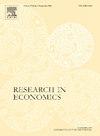韩国的生育率下降和税收
IF 1.3
Q3 ECONOMICS
引用次数: 0
摘要
本研究调查了韩国税收与生育率之间的联系,重点关注70年代中期税收改革前后的历史时期。生育率的长期下降与人力资本增加、妇女就业和住房成本上升等因素有关,导致夫妇推迟或放弃生育决定,这一问题已被广泛讨论。然而,对影响可支配收入和经济规划范围的税收政策如何间接影响生育选择的关注较少。虽然税收对于为社会保障体系提供资金至关重要,但不考虑人口影响而减少家庭资源的政策可能会对人口动态产生意想不到的后果。我们利用世界银行国家-年份的时间序列,将韩国20世纪70年代中期的重大税收改革作为自然实验,来检验更高的税收负担也有助于在随后的几十年里降低生育率的假设。结果表明,20世纪70年代中期韩国税制改革对生育率产生了相当大的负面影响。这一宏观分析表明,税收政策可以影响人口动态,但缺乏对税收变化如何影响家庭生育决策的洞察。未来微观层面的研究可以揭示税收政策和生育行为之间的联系机制。尽管如此,这项研究强调了税收政策对人口的潜在影响。政策制定者在修改税收制度时应考虑到这些后果,特别是与家庭资源和儿童负担能力有关的政策。本文章由计算机程序翻译,如有差异,请以英文原文为准。
Fertility decline and tax revenues in South Korea
This study investigates the link between taxation and fertility in South Korea, focusing on the historical period surrounding the mid-70s tax reforms. The longstanding decline in fertility rates has been widely discussed in relation to factors such as increasing human capital, women’s employment, and rising housing costs, leading couples to postpone or forego childbearing decisions. However, less attention has been paid to how tax policies that influence disposable income and economic planning horizons could indirectly affect fertility choices. While taxation is crucial for funding social security systems, policies that reduce household resources without considering demographic impacts may have unintended consequences on population dynamics. Using a time-series of country-year from the World Bank, we exploit South Korea’s major mid-1970s tax reforms as a natural experiment to test the hypothesis that higher tax burdens also contributed to reducing fertility over the subsequent decades. The results suggest considerable negative effect of the mid-1970s tax reforms on fertility in South Korea. This macro-analysis shows tax policies can influence population dynamics, but lacks insight into how tax changes affected childbearing decisions at the household level. Future micro-level studies could reveal mechanisms linking tax policies and fertility behavior. Still, this study highlights potential demographic impacts of taxation policies. Policymakers should consider such consequences when modifying tax systems, especially policies related to family resources and child affordability.
求助全文
通过发布文献求助,成功后即可免费获取论文全文。
去求助
来源期刊

Research in Economics
ECONOMICS-
CiteScore
1.40
自引率
0.00%
发文量
37
审稿时长
89 days
期刊介绍:
Established in 1947, Research in Economics is one of the oldest general-interest economics journals in the world and the main one among those based in Italy. The purpose of the journal is to select original theoretical and empirical articles that will have high impact on the debate in the social sciences; since 1947, it has published important research contributions on a wide range of topics. A summary of our editorial policy is this: the editors make a preliminary assessment of whether the results of a paper, if correct, are worth publishing. If so one of the associate editors reviews the paper: from the reviewer we expect to learn if the paper is understandable and coherent and - within reasonable bounds - the results are correct. We believe that long lags in publication and multiple demands for revision simply slow scientific progress. Our goal is to provide you a definitive answer within one month of submission. We give the editors one week to judge the overall contribution and if acceptable send your paper to an associate editor. We expect the associate editor to provide a more detailed evaluation within three weeks so that the editors can make a final decision before the month expires. In the (rare) case of a revision we allow four months and in the case of conditional acceptance we allow two months to submit the final version. In both cases we expect a cover letter explaining how you met the requirements. For conditional acceptance the editors will verify that the requirements were met. In the case of revision the original associate editor will do so. If the revision cannot be at least conditionally accepted it is rejected: there is no second revision.
 求助内容:
求助内容: 应助结果提醒方式:
应助结果提醒方式:


